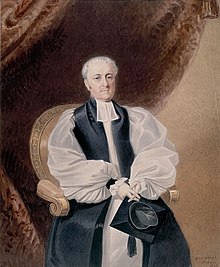William Broughton (bishop)
|
The Right Reverend William Grant Broughton |
|
|---|---|
| Bishop of Australia | |

Portrait of Broughton by William Nicholas
|
|
| Church | Church of England |
| Diocese | Anglican Diocese of Australia |
| Orders | |
| Consecration | 1836 |
| Personal details | |
| Born |
May 22, 1788 Westminster |
| Died | February 20, 1853 (aged 64) London |
| Buried | Canterbury Cathedral |
| Denomination | Anglican |
| Spouse | Sarah Francis |
| Previous post | Archdeacon of New South Wales |
| Education | The King's School, Canterbury |
| Alma mater | Pembroke College, Cambridge |
William Grant Broughton (22 May 1788 – 20 February 1853) was the first (and only) Bishop of Australia of the Church of England. (The Diocese of Australia was later divided into a number of smaller dioceses.)
Broughton was born in Westminster and educated at The King's School, Canterbury where he was a King's scholar. His fortunes turned from commerce to theology when he inherited a substantial sum, allowing him to study at Pembroke College, Cambridge. He graduated B.A. as 6th wrangler in 1818 and was that year also ordained deacon and priest and married to Sarah Francis. He graduated M.A. in 1823. He became a curate in Hampshire and later in Surrey where he was noticed by the Duke of Wellington who materially assisted his prospects, including influence in Broughton being offered the Archdeaconry of Sydney.
Broughton arrived in Sydney on 13 September 1829, succeeding Thomas Scott as Archdeacon of New South Wales (that at the time substantially encompassed what is now the states of New South Wales plus Queensland to the north and Victoria to the south.) At this time, the colony was ecclesiastically an archdeaconry of the Anglican Diocese of Calcutta. Broughton offered to resign half of his professional income (£2500) to support a second See, "an instance of self-devotion," said a contemporary writer, "with scarcely a parallel." The Government accepted only £500 a year from him.
Broughton was promptly made a member of both the colony's legislative council and executive council, assisting the Governor in the administration. He was also in charge of the commission for the overall policy towards Tasmanian natives which continued the policy of bounties and roving parties. He was granted a leave of absence and returned to England in 1834, there championing the cause of the church. The result was not as he expected; the Diocese of Australia was to be formed. He was enthroned Bishop of Australia, on 5 June 1836, in St James' Church, Sydney, as leader of the new Diocese of Australia just days after his arrival from England.
...
Wikipedia
